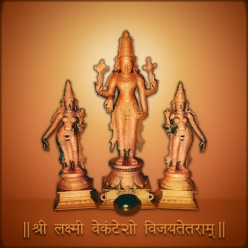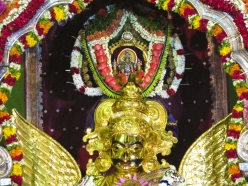Cochin Tirumala Devaswom
Cochin Thirumala Devaswom is the biggest and most important socio-religious institution of Gowda Saraswat Brahmins of Kerala. It is also one of the famous Mahakshetrams of Kerala. It is always a festive mood at the temple with daily, weekly monthly and yearly functions and special sevas conducted by the community members.
Gosripuram is the only one of its kind, in terms of architectural splendour and style. Not many temples in India can match its grace and elegance. The sanctum Sanctorum of the temple is built in Nagara Style of Hindu temple architecture with the customary copper plated roof and an imposing gold sikha.
In the outer courtyard (prakara) of the main temple there are four small temples that are dedicated to Sri Hanuman, Ganapathi, Garuda and Mahalakshmi. The massive idols of Hanuman and Garuda reaching up to over 6 feet and the huge Siva lingam dedicated to Udyaneswara ( Siva) on the north eastern side of the Lake Mandapam are the main attractions of the temple. There is also a Navagraha temple dedicated to the nine different planets of the solar system that is situated on the South Western corner of the Udyaneshwar temple.
Gosripuram Temple has many other firsts to its credits. It has one of the biggest temple bells in the country. Suspended from a massive wooden frame that rests over four massive granite pillars- each one carved out of a single rock- this bell is one of the most important landmarks of this beautiful temple. The temple flaunts exquisite wood carvings of figurines that are ornately decorated and decked up. These depict stories from the Hindu epics of Ramayana and Mahabharata.
Vimana shaped Sreekovil
Parsvamantapam is the next hall in front of the main temple inside the periphery. At the Southern end of Parswamantapam is erected Twelve Pillar Silver Mantapam for Kalyana Utsavam. The Chandeliers and Electric Globes and Domes add to the decor of the Parsvamantapam. The Exquisite Carvings on the inner ceilings depicting episodes from the Ramayana, Mahabharata, Bhagavatham etc, make Namaskara Mantapam and its flanks more attractive. In the centre of Vimana Shaped Sreekovil, the sanctum sanctorum, is seen the beautiful throne artistically finished on a single stone and coated with sandal paste.
The main idol of Venkateswara, his consorts, Sreedevi and Bhoodevi on either side is situated at the top of the throne, Utsava Murti with consorts in the middle and Utsava Lakshmi at the lower layer. On the lowest layer are the Salagramas. Poojas & Festivals are conducted as prescribed by the scriptures namely the Aagama Sastra and particularly the Padma Samhita. A number of glittering Ghee Flames from different varieties of Gold, Silver and Bronze lamps keep the sanctum sanctorum always bright and shining.
The Gold Garuda, Gold Palanquin and Gold Unjal bear and share much for the Fame and Glory of the Ancient Temple. A word about the architecture of the temple. Its sanctum sanctorum is of the Nagara style of architecture. The temple is also rich in wood work and exquisite paintings, which depict stories from Ramayana and Mahabharata. The northern Gopuram, a two storeyed structure with copper roof, is of the pagoda type resembling the Tibeto Indian style of architecture. Beautiful paintings done by indigenous craftsmen depicting various scenes from the Puranas and epics adorn its ceiling.
The two main temple festivals popularly known as 'Aratt' are the most important events of the year. Two eight day long festivals (Rathotsavam and Mahotsavam) are celebrated in the temple annually. Mahotsavam is in commemoration of the first Pratistha and it ends on the full moon day of the month Chaitra (March-April). Rathotsavam performed in the month of November-December is similar to Mahotsavam in all respects except on the afternoon of the seventh day of festival, the Lord is taken round the temple in a special chariot known as Pushpaka Vimanam.











